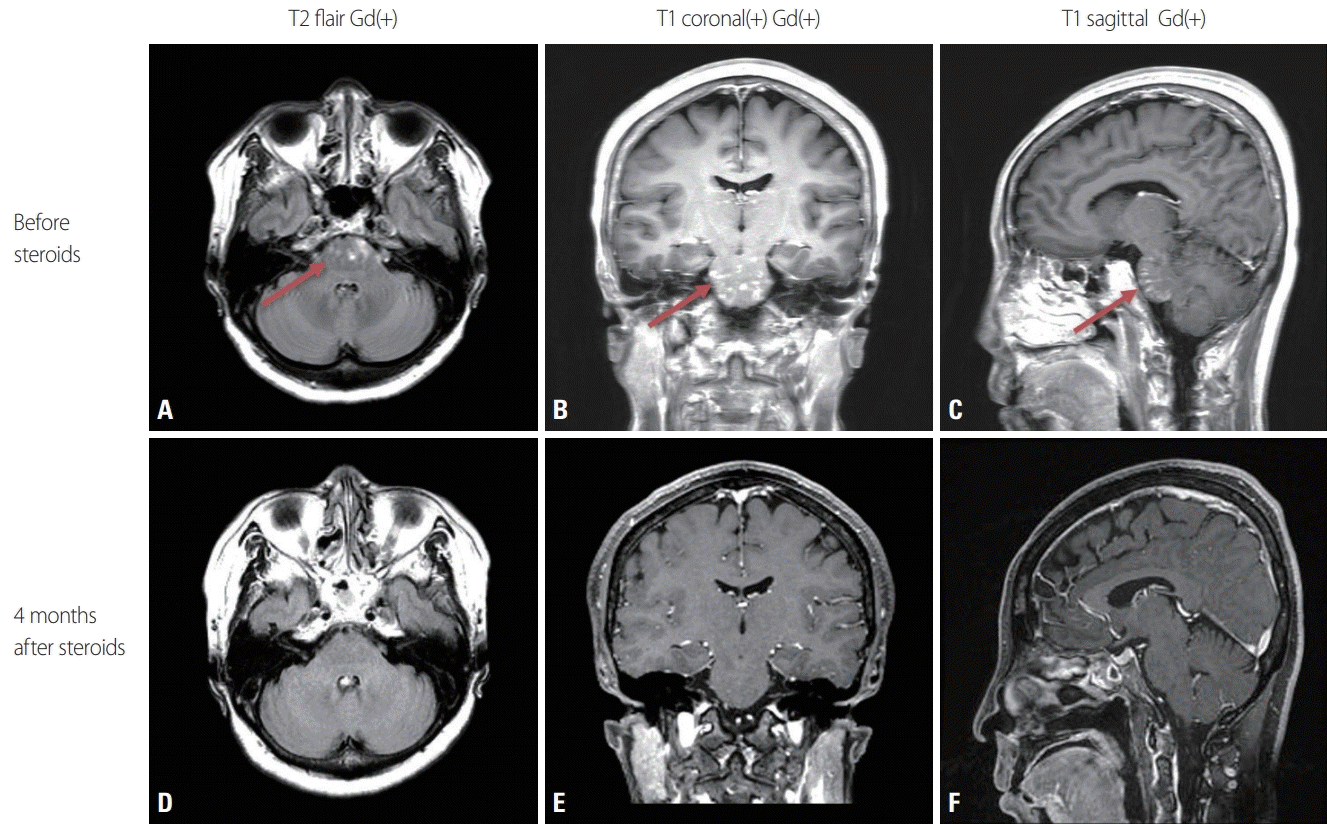Chronic lymphocytic inflammation with pontine perivascular enhancement responsive to steroids (CLIPPERS) is a treatable inflammatory disorder of the central nervous system (CNS), especially involving the cerebellum, spinal cord, or brainstem. The typical presenting features of CLIPPERS in brain magnetic resonance imaging (MRI) are multiple punctate and curvilinear gadolinium-enhanced lesions peppering the pons.1 Here we report a patient with gait disturbance and dysarthria who was diagnosed with probable CLIPPERS.
A 57-year-old female visited our hospital with complaints of gait disturbance, dysarthria, and diplopia with a 2-week history. She had previously been healthy with no history of medications. She presented with ataxic gait with tilting on both sides, but she had no other symptoms or signs such as motor and sensory focal deficits of the limbs. Normal findings were obtained in all of the applied laboratory tests, including for autoimmune and paraneoplastic antibodies in her serum, for oligoclonal bands, IgG index, viral markers, and cytology in her cerebrospinal fluid, and for infection, vasculitis, and demyelinating CNS disease. The findings of nerve conduction tests (including the blink reflex) and brain MR angiography were also normal. She underwent brain MRI with gadolinium enhancement, which revealed patchy increased signal intensities in the pons, with strong contrast enhancement (Fig. 1). She was treated with a high-dose steroid pulse therapy (methylprednisone at 500 mg for 5 days). Her symptoms improved significantly after this treatment, and she was discharged on prescribed oral prednisone. Follow-up MRI was performed after 4 months, which revealed complete resolution of the enhancing abnormalities.
With CLIPPERS, as the name already implies, both clinical and radiological features are rapidly improved by treatment with high-dose intravenous methylprednisone. However, diagnosing CLIPPERS is challenging, primarily due to the lack of a gold-standard diagnosis method, and secondarily because its pathogenesis is poorly understood.2 These reasons mean that the most-important findings for distinguishing CLIPPERS from other diseases are its typical radiological findings including multiple, homogeneous, small (<3 mm in diameter), and curvilinear gadolinium-enhanced nodules in the pons and cerebellum.1 Clinicians suspicious of CLIPPERS with the characteristic radiologic pattern could diagnose it based on the diagnostic criteria for CLIPPERS proposed by Tobin et al.3 Despite its rarity, this treatable condition still needs to be considered.
REFERENCES
1. Pittock SJ, Debruyne J, Krecke KN, Giannini C, van den Ameele J, De Herdt V, et al. Chronic lymphocytic inflammation with pontine perivascular enhancement responsive to steroids (CLIPPERS). Brain. 2010; 133:2626–2634.

2. Dudesek A, Rimmele F, Tesar S, Kolbaske S, Rommer PS, Benecke R, et al. CLIPPERS: chronic lymphocytic inflammation with pontine perivascular enhancement responsive to steroids. Review of an increasingly recognized entity within the spectrum of inflammatory central nervous system disorders. Clin Exp Immunol. 2014; 175:385–396.

Fig. 1.
FLAIR axial (A, D) and gadolinium-enhanced T1-weighted coronal (B, E) and sagittal (C, F) brain magnetic resonance imaging (MRI). Initial MRI revealed foci of gadolinium enhancement with a punctate and curvilinear pattern, predominantly in the pons (arrows). Follow-up MRI performed 4 months after steroid therapy revealed a marked reduction in the extent of gadolinium-enhanced lesions.





 PDF
PDF Citation
Citation Print
Print



 XML Download
XML Download